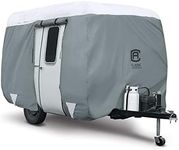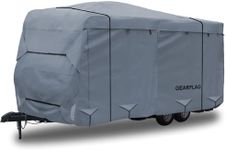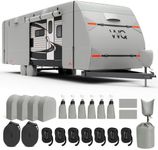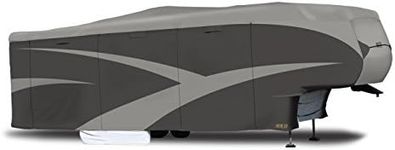Buying Guide for the Best Rv Covers
Choosing the right RV cover is essential to protect your recreational vehicle from weather, dust, and other environmental factors when it's not in use. A good RV cover can extend the life of your RV's exterior and help maintain its value. When shopping for an RV cover, it's important to consider the size, material, weather resistance, fit, and ease of use. Understanding these key specifications will help you find a cover that matches your needs and ensures your RV stays in great condition.Size and FitSize and fit refer to how well the cover matches the dimensions of your RV. This is important because a cover that's too small won't provide full protection, while one that's too large can flap in the wind and cause damage. RV covers are usually categorized by length and sometimes by type (such as travel trailer, fifth wheel, or motorhome). To pick the right size, measure your RV from end to end, including any ladders or spare tires, and choose a cover that matches or slightly exceeds these measurements. A snug fit is best for maximum protection.
MaterialThe material of an RV cover determines its durability, breathability, and resistance to elements like UV rays, rain, and snow. Common materials include polyester, polypropylene, and sometimes reinforced fabrics. Heavier materials offer better protection against harsh weather but may be harder to handle, while lighter materials are easier to put on and remove but may not last as long. If you store your RV outdoors in extreme weather, look for multi-layer or reinforced materials. For mild climates or indoor storage, a lighter material may be sufficient.
Weather ResistanceWeather resistance describes how well the cover protects against sun, rain, snow, and wind. This is crucial for preventing damage like fading, cracking, or mold growth. Some covers are designed specifically for UV protection, while others focus on being waterproof or water-resistant. If your RV will be exposed to strong sun, prioritize UV resistance. For rainy or snowy areas, look for waterproof or water-repellent covers with good ventilation to prevent moisture buildup underneath.
VentilationVentilation refers to the cover's ability to allow air to circulate, which helps prevent mold, mildew, and condensation from forming under the cover. Many covers include built-in vents or breathable panels. If you live in a humid area or plan to cover your RV for long periods, good ventilation is especially important. Choose a cover with multiple vents or breathable fabric to keep your RV dry and fresh.
Ease of UseEase of use covers how simple it is to put the cover on and take it off, as well as how easy it is to access your RV while it's covered. Features like zippered panels, adjustable straps, and elastic hems can make handling the cover much easier. If you plan to access your RV while it's stored, look for covers with zippered doors. For frequent use, prioritize covers that are lightweight and have clear instructions for installation.
Securing MechanismsSecuring mechanisms are the straps, buckles, and elastic hems that keep the cover in place, especially during windy conditions. A good securing system prevents the cover from shifting or blowing off, which can cause scratches or leave parts of your RV exposed. Look for covers with multiple adjustable straps, reinforced corners, and strong buckles. If your area is prone to high winds, a cover with extra tie-downs or weighted hems will provide better security.


















